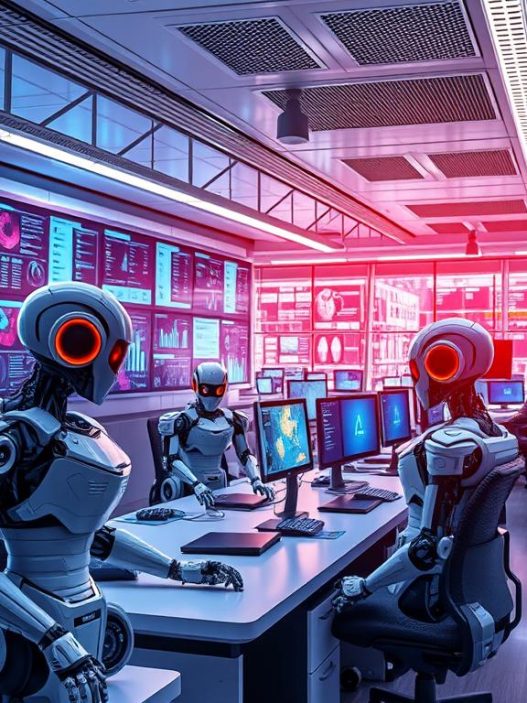In the fast-changing world, AI is making big changes in many areas, including construction. The construction industry, worth over $10 trillion, is starting to use new tech for taking care of equipment. Old ways of checking if equipment needed repairs took a lot of time and hard work. Now, AI helps managers save time and money, and makes work sites safer.
AI is changing how we take care of construction equipment before it breaks down. This involves using machine learning and data analysis to spot problems early. By looking at equipment data and past records, AI can predict breakdowns ahead of time. With AI, operations run smoother, equipment lasts longer, unexpected costs go down, and there are fewer urgent repairs. This piece explores the big wins of using AI for maintenance and its impact on managing construction equipment.
Key Takeaways
- AI-driven predictive maintenance offers a proactive approach to equipment management.
- Condition-based maintenance (CBM) and predictive analytics enhance maintenance efficiency.
- Incorporating AI solutions significantly reduces unexpected downtime and maintenance costs.
- Proper training and integration are essential for successful implementation of AI in maintenance.
- AI algorithms analyze vital data to predict equipment issues in advance, ensuring safety.
- Predictive maintenance has the potential to increase overall productivity and extend equipment lifespan.
Introduction to AI in Construction Equipment Maintenance
The use of AI for construction equipment maintenance is changing the game. It shifts from old-school repair methods to a smarter, predictive maintenance model. This change lets construction firms use construction technology to get better. AI tools, like machine learning and computer vision, let companies analyze data in real time. This means they can spot problems early, avoiding big repair costs.
A report from McKinsey highlights the growing need for AI integration in construction. With global construction costs over $10 trillion a year and set to grow by 4.2% until 2023, saving time and money is crucial. AI helps improve the process at every stage, from design to managing finished projects.
The construction industry often faces worker shortages. So, companies are using AI to good effect. AI helps with smart planning for workers and machines, cutting idle time. Also, AI-powered autonomous vehicles make managing equipment easier. This allows for better productivity in a more controlled setting.
Predictive maintenance, powered by AI, has the power to cut maintenance costs and make equipment last longer. For instance, AI sensors can spot fuel wastage, leading to smarter use of resources. As AI gets better, construction firms will see fewer delays and less wasted time. This boosts productivity and cost-effectiveness, key for competing today.
| AI Applications in Construction Maintenance | Description | Benefits |
|---|---|---|
| Predictive Maintenance | Utilizes data analysis to forecast equipment failures. | Reduces costs and downtime. |
| Real-Time Monitoring | Monitors equipment performance continuously through AI algorithms. | Enables immediate interventions to prevent issues. |
| Fuel Optimization | AI sensors analyze and optimize fuel consumption. | Lower operational costs and improve efficiency. |
| Logistics Strategy | AI helps create efficient equipment usage schedules and hauling routes. | Increases overall site productivity. |
The Importance of Predictive Maintenance for Construction Equipment
The construction sector is booming, thanks to urban growth and new tech. The role of importance of predictive maintenance is critical here. Equipment downtime is a big problem. It causes unexpected costs and delays in projects. Predictive maintenance software for heavy machinery helps. It lets construction companies see issues early, affecting both time and money positively.
Predictive maintenance uses data and modeling to know when machinery needs care. This approach cuts downtime and costs. It also makes machinery last longer. Teams do regular checks and tests to spot problems early. This helps avoid big repair bills.
The CMMS+ by LLumin is a great example of smart construction equipment maintenance management. It makes maintenance work smoother, improves uptime, and saves money. Using AI for predictive maintenance helps companies spend less on operations and makes equipment more reliable.
It’s important to train the maintenance crew well. They need to know how to use the latest tech. Technology like AI can cut maintenance costs by 20%. It also greatly reduces sudden breakdowns.
Using machine learning to foresee equipment failure is smart. It uses past data and current sensor readings. This detailed method saves money, boosts safety, and increases work site efficiency.
Benefits of Predictive Maintenance AI for Construction Equipment
Predictive maintenance AI brings big changes to construction. It tackles issues like machine downtime and high costs, boosting efficiency and profits.
Reduced Downtime and Increased Efficiency
One big win with AI in construction is cutting downtime. AI uses data to foresee breakdowns before they strike. This lets teams fix things before busy times, keeping work smooth and projects on schedule. With fewer surprises, work gets done faster, using resources well.
Cost Savings Through Proactive Management
Being ahead of problems cuts construction costs. Predictive maintenance spots early signs of trouble, meaning less rush fixes and longer life for gear. Using tools like LLumin’s CMMS+, companies organize upkeep better and save money. This planning keeps gear running longer at lower costs, raising profits.
How Predictive Maintenance AI Works
Predictive maintenance AI has changed the construction industry. It uses a step-by-step method to keep construction tools working well. Advanced algorithms and data analytics help make equipment more reliable.
Data Collection and Analysis
The core of predictive maintenance is data collection and analysis. Sensors in construction equipment track things like how long they run, their load, and stress levels. The data is then analyzed using AI. This helps find issues before they become big problems.
Real-Time Monitoring of Equipment Performance
Real-time data is key to predictive maintenance. It lets managers know about problems right away. This helps avoid expensive stoppages and keeps construction running smoothly. It makes equipment last longer and boosts work efficiency.
| Data Point | Collection Method | Analysis Technique | Outcome |
|---|---|---|---|
| Operating Hours | Embedded sensors | Machine learning algorithms | Predictive insights on usage |
| Load Capacity | Sensors on lifting devices | Statistical analysis | Maintenance scheduling |
| Wear Levels | Wear sensors | Anomaly detection | Proactive replacements |
| Mechanical Stress | Vibration and pressure sensors | Predictive modeling | Enhanced safety measures |
Predictive maintenance makes construction safer and more efficient. It helps get the most value from equipment while reducing downtime.
AI Solutions for Construction Equipment Maintenance
The construction industry is growing quickly and so are AI maintenance solutions. These tools use predictive maintenance to improve equipment use. They help cut downtime and maintenance costs.
CBM systems have sensors to watch equipment for wear and tear. They alert for repairs right away, so managers can act fast. This means equipment performance data can be checked from anywhere, making it easier to fix issues quickly.
Predictive analytics is key in these AI solutions. It looks at past and current data to predict equipment failures. This way, problems are found early, cutting repair costs and keeping production running smoothly.
“AI technologies are essential in identifying and resolving operational inefficiencies within manufacturing processes, boosting overall productivity and efficiency.”
AI also makes construction equipment management easier. With TPM, everyone helps with maintenance. AI tools share important data. PPM, done regularly, lowers the chance of failure. It focuses on important maintenance using AI.
| AI Solution | Description | Benefits |
|---|---|---|
| Condition-Based Maintenance (CBM) | Uses sensors to monitor equipment performance | Real-time alerts for necessary repairs |
| Predictive Analytics | Analyzes historical data to forecast failures | Reduces downtime and repair costs |
| Remote Monitoring Tools | Allows management oversight from any location | Facilitates timely decision-making |
| Total Productive Maintenance (TPM) | Involves all staff in maintenance management | Improves staff involvement and data sharing |
AI solutions give construction companies a big edge. With AI’s market value hitting USD $5 billion by 2030, those who use these tools will lead the industry.
Challenges and Considerations in Implementing AI
The introduction of AI for predictive maintenance in construction faces unique challenges. Organizations must deal with the high initial costs. These include the money spent on sensors, data management, and analysis tools. Predictive maintenance AI’s setup can strain budgets, hitting smaller companies hard.
Initial Investment and Training Requirements
Aside from the money aspect, firms encounter obstacles in AI training for construction workers. Using these advanced tools requires detailed training programs. It’s vital to have skilled people to inspect the data from sensors and IoT devices. Constant training helps workers keep up with AI’s quick changes.
Beating these challenges needs a well-rounded strategy:
- Data Security: Setting up data management and access rules is key to protect private information.
- Resource Allocation: Time and resources should be efficiently used to manage data.
- Monitoring KPIs: It’s critical to establish metrics like mean time between failures (MTBF) to check efficiency.
- Budgeting: Careful financial planning helps understand AI’s long-term cost impact.
- ROI Calculation: Calculating the return on investment from better asset management and maintenance is crucial.
Tackling AI challenges in construction boosts early adoption and long-term gains. By overcoming these hurdles, businesses can greatly improve their maintenance strategies and efficiency.
| Challenge | Description | Potential Solution |
|---|---|---|
| Initial Costs | High expenses for technology implementation. | Conduct detailed cost-benefit analysis. |
| Resource Allocation | Significant time required for data handling. | Develop streamlined data collection processes. |
| AI Training for Workers | Need for skilled personnel to operate AI systems. | Implement ongoing training programs and workshops. |
| Data Security | Risk of data breaches and sensitive information loss. | Establish robust cybersecurity measures. |
| Monitoring KPIs | Tracking performance indicators reliably. | Use AI-driven dashboards for real-time insights. |
Conclusion
The future of predictive maintenance in construction looks very promising, thanks to AI. This technology is changing how we handle maintenance. It makes everything more efficient. Now, using AI to guide maintenance trends is crucial for success.
Predictive maintenance is about preventing problems before they happen. It helps avoid unexpected equipment failures and keeps projects running smoothly. This approach saves time and reduces costs.
By investing in predictive maintenance, construction firms can cut expenses. This is done by fixing things early before they turn into big problems. Monitoring equipment helps keep it running longer and safer. Catching issues early also means fewer accidents at work sites.
The construction world is changing rapidly. Companies using AI for maintenance will stand out. Focusing on predictive maintenance improves project management and cost-saving. It prepares the construction industry for future challenges.








